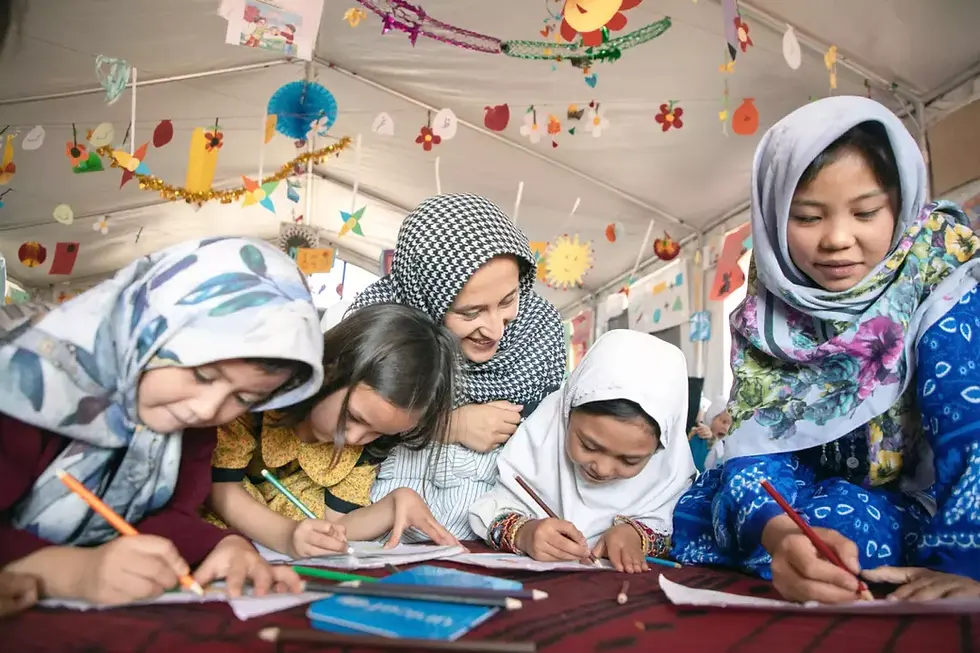Children’s Mental Health in Afghanistan
- UNICEF Team uOttawa
- Mar 16
- 3 min read
Updated: Aug 1
Soha Khan - Awareness Content Reporter

Due to the devastating circumstances within Afghanistan in the recent decades, mental health concerns are extremely common amongst people of all ages in the country. In particular, children from age 5-17 experience anxiety at a rate 10 times higher than the global average - over 24% (Houser, 2024). The political violence and environmental disasters in Afghanistan have caused young people to experience various types of trauma, and have put much of the population in a position of poverty and famine, making it difficult to survive and be mentally well. So, as a part of UNICEF’s mission to help Afghanistan through their humanitarian crisis, a focus on children’s mental health is crucial. UNICEF has implemented many programs to help improve the conditions of children’s well-being in Afghanistan.
Children’s mental health issues in Afghanistan are rooted in various conflicts that exist in the area. Political turmoil, poverty issues, family displacement, forced migration, recurrent natural disasters, etc. have all played major roles in the advancement of this issue, and the need to act and reverse the effects. Due to these circumstances, children’s lives and situations have altered dramatically, which has resulted in increased levels of anxiety and trauma. Moreover, health, education, and support services in Afghanistan already hold little hope for future prosperity for many young people, and this coupled with the societal stigma around mental health support only amplifies the mental health struggles faced by youth (Houser, 2024).
UNICEF has understood this struggle and the barriers present in overcoming it, so they have provided various methods of support for youth in Afghanistan. Firstly, UNICEF has recognized the need for children to have a comfortable environment in which they feel safe and connected to the community, in order to feel like they are able to open up about struggles they may be having. This is why 750 child-friendly spaces have been established in Afghanistan (Houser, 2024). These spaces were developed with the intent of training community leaders to run the facilities, to ensure that this effort is sustainable. Designed to provide a welcoming environment of inclusion and activity, these spaces work to ensure that children feel at ease and able to congregate with others (Houser, 2024). With these environments, children are better able to have open discussion of issues they may be facing with their mental health, which is often the first step towards recovery, and a major sign of progress for a country with such limited mental health services.
Child-friendly spaces in Afghanistan open up the opportunity for children to feel comfortable enough to speak to social workers and counselors. However, considering the deficiency in mental health workers, psychologists, etc. in Afghanistan, UNICEF took action to improve facilities on this front as well. UNICEF has helped train workers specializing in mental health to improve in their approach to children’s needs (Phwitiko, 2024). They also work to break down the existing social stigmas surrounding mental health by spreading awareness about mental health needs and information to members and caregivers of the community.
Moreover, children’s mental health issues in Afghanistan are closely related to actions and customs of their parents and caretakers. Due to deeply-rooted traditions in Afghanistan, adults may make decisions, like permitting a child marriage, or refusing to send a daughter to school, that may have negative effects on the wellbeing of their child. However, with the aid of UNICEF, many have been able to adopt new knowledge and beliefs that have influenced the actions they have taken with their children. For example, UNICEF’s Social and Behaviour Change Programme in Afghanistan was designed to work with community and faith-based organizations to understand their wants, needs, and behaviours, in order to help them adopt attitudes that will better fit their child’s lives, and consequently improve their wellbeing (Phwitiko, 2024). Harmful practices like child marriage and a lack of education are significant catalysts to a decline in a child’s mental health, and this program has helped many shift their mindsets and positively impact their children.
UNICEF has devised many tactful methods of improving the mental health and wellbeing of children in Afghanistan amongst a multitude of traumatic events and systems. By mindfully understanding the customs and needs of the Afghan people, and integrating them fully into the methods of improvement, UNICEF has been able to achieve a great deal of positive change for children’s mental health issues in Afghanistan.
References
Houser, V. (2024, July 8). Hugs, happiness, and healing: How UNICEF is addressing children’s struggles with mental health through child-friendly spaces and psychosocial support. UNICEF.
https://www.unicef.org/afghanistan/stories/hugs-happiness-and-healing
Phwitiko, R. (2024, February 11). Igniting positive change for children: How
UNICEF-supported strategies help families and communities make better decisions. UNICEF.
https://www.unicef.org/afghanistan/stories/igniting-positive-change-children




Comments